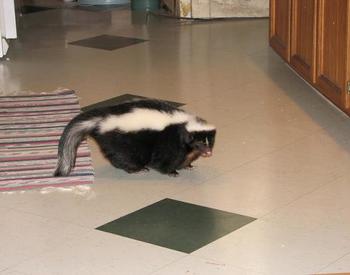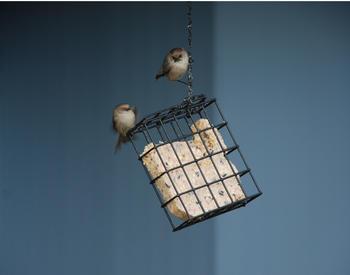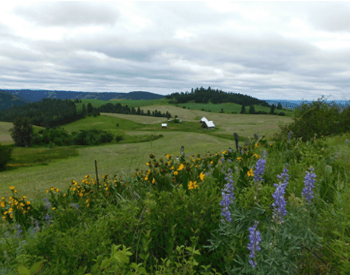Healthy sagebrush rangelands provide a bounty of food for livestock and wildlife, including sage-grouse. However, not all "grocery stores" — or portions of the range — are equivalent, and sage-grouse and cattle often "shop" for different food items during different times of year and periods of their lives.
Unlike cattle, which primarily consume grasses, sage-grouse prefer to eat sagebrush, wildflowers (aka forbs) and the insects they attract. As adults, sage-grouse always have sagebrush on the menu, eating it exclusively over winter. This is possible thanks to their unique digestive system, which separates the toxins from sagebrush. After surviving on sagebrush all winter, grouse eat forbs and insects as they become available during spring.
Just as cows with calves have different nutritional requirements, sage-grouse with their chicks (group of chicks are called a brood) consume foods with higher protein, such as forbs and insects. Summer is the only season when sagebrush is not the majority of the adult sage-grouse diet. Their diet is about 20% insects and 50% forbs in summer.
Sage-grouse are sometimes called desert chickens. But unlike chickens, sage-grouse do not have a muscular gizzard that holds grit, so they cannot consume seeds. Instead, they eat the softer sagebrush leaves, wildflower stems, leaves and buds. Young grouse chicks exclusively eat forbs and protein-rich ants, beetles, grasshoppers and other bugs until they are 3 weeks old, when they start consuming sagebrush. By their first winter, they eat like adults.
Sage-grouse groceries depend on weather, rangeland health and soil conditions in sagebrush rangelands. Areas of sagebrush with perennial understories have great groceries, but what about rangeland where the understory is dominated by invasive annual grasses, or anything in between? Recent research by OSU’s SageHabitatTeam suggests that some cheatgrass might not be as bad for sage-grouse as we thought. The good news is, if the range has some cheatgrass invasion with an intact sagebrush canopy, it can still feed grouse throughout the year, as there can be enough insects in these areas to support chicks and adults. This doesn’t mean that cheatgrass is good, but it can be tolerable.
The research also found that the more forbs, the better. More forbs meant more bugs, a double win for grouse groceries. Conversely, in monocultures where cheatgrass dominates, excluding forbs and grasses, neither the bird nor the herd benefits.
If you live in sagebrush country, you know that wildfire is one of the biggest threats to this ecosystem. More cheatgrass also means higher fire risk: The fine fuels from cheatgrass make fire more likely to start and easier to spread once lit. When sagebrush rangelands with some cheatgrass burn, this often results in more cheatgrass and no sagebrush post-fire.
Grouse rely on sagebrush for both food and to hide from predators, so no matter how great the groceries are, they rarely risk shopping in areas without sagebrush cover nearby. What does this mean for rangeland management? To protect the bird and the herd, it’s best to protect areas of sagebrush with cheatgrass in the understory from burning. Management that promotes healthy rangelands and increased forbs will not only benefit sage-grouse, but will help increase pollinators, which are declining globally.
Less cheatgrass and more forbs mean more fire-safe and nutritious rangelands for grouse, pollinators and cattle.
What you can do at the ranch: Keep on top of the weeds! This could simply mean stopping the spread: Treat roads to keep weeds from hitching a ride, spray off trucks and equipment after traveling through infested areas, and ensure your hay is weed-free.
Since grouse also need groceries throughout the summer, protecting a variety of habitats across the range will allow for continued food resources. As the rangeland starts to dry up in summer, heat and cattle are moved to greener pastures and wetter areas.
Grouse also head to higher elevations or wet riparian zones in search of bugs and forbs. However, this search for groceries can be dangerous for grouse. Trees such as juniper are more prevalent in higher elevations and can harbor predators ready to dine on sage-grouse chicks. The best way to protect grouse groceries on rangelands is to ensure there are a variety of areas without many trees and with plenty of cover and forbs including drylands, higher elevation uplands and wet riparian areas and streams.
We are now living with new realities on the range. Realistically, we will never eradicate cheatgrass; we must learn to live with and manage it. The good news is that in areas with sagebrush, some cheatgrass isn’t disastrous for grouse. There are still enough insects to go around, as long as some forbs remain. For more details on the OSU research that assessed sage-grouse dietary requirements and nesting habitat under varying cheatgrass levels, contact Jon Dinkins [email protected].
Note: This article originally appeared in Oregon Beef Producer magazine in summer 2023.



















